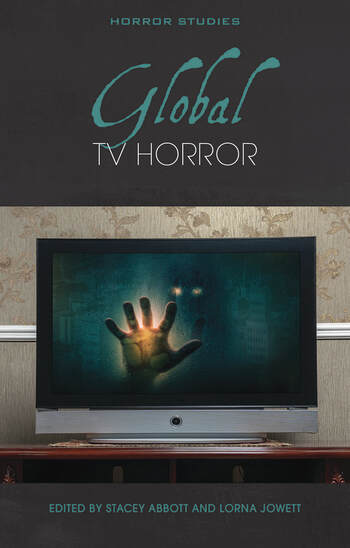
TITLE: Global TV Horror
AUTHOR: Stacy Abbott and Lorna Jowett (Editors)
PUBLISHER: University of Wales Press
ISBN: 9781786836946
PODCAST EPISODE: None
REVIEWER: Hilary Wilson
Many critics have said that in that last decade we entered a Golden Age of Television Horror. The Walking Dead, Supernatural, and Stranger Things have commanded massive global audiences and the desire for more genre content is booming. In short, the television horror fandom is thriving with new conventions, podcasts, and merchandise being released every day. Isn’t it time for a book dedicated to studying precisely that?
Global TV Horror is the newest entry in the series Horror Studies published by University of Wales Press. This series is the very first dedicated exclusively to the study of horror on the small screen. While previous publications on the study of horror have primarily focused upon cinema or literature, this book focuses upon the little-studied field of horror in television. Naturally, given the way that media has changed with the advent of streaming services and Video On Demand, it made sense for the book to further expand that field to include international programs rather than focusing upon only Anglophone productions.
The book is composed of thirteen essays which are each divided into three sections: National Contexts, Form, and the Industry itself. National Contexts focuses upon how national identity of the creators of the productions informs television shows. How, for instance, do Iranian creators portray the vampire when their country has little to no myths and folklore surrounding vampirism? How does Australia’s colonialist history inform a slasher thriller? How did the Cuca, a Brazilian child eating witch without a static form, become an LGBTQ+ icon? All of these questions and more are answered and explored through enlightening essays.
The second section focuses upon the ways in which horror is evoked through the television medium and the ways in which the industry has changed in recent years. Television horror often lacks the budgets that cinema films have, and so have to rely upon conveying horror through means other than strictly special effects. Practical effects, clever audio engineering, and the ingenious evocation of the liminal are all touched upon as means to convey horror. Likewise, the effects of using supernatural contexts and absurdism to convey complex political messages comes into play.
The third section focuses upon distribution methods and how those have changed over time. Video On Demand including avenues such as YouTube have opened up international horror to a far larger audience. Previously obscure small-scale productions can now be seen by anyone around the globe, and day-of streaming on an international scale has allowed phenomena like The Walking Dead to thrive.
Horror, in general, has largely been regarded as a lesser genre unworthy of scholarly study. This book proves that that has never needed to be the case. These easily accessible, entertaining, and scholarly essays legitimize the study of horror and leave the door wide open for more inquiries to be made in the future.
AUTHOR: Stacy Abbott and Lorna Jowett (Editors)
PUBLISHER: University of Wales Press
ISBN: 9781786836946
PODCAST EPISODE: None
REVIEWER: Hilary Wilson
Many critics have said that in that last decade we entered a Golden Age of Television Horror. The Walking Dead, Supernatural, and Stranger Things have commanded massive global audiences and the desire for more genre content is booming. In short, the television horror fandom is thriving with new conventions, podcasts, and merchandise being released every day. Isn’t it time for a book dedicated to studying precisely that?
Global TV Horror is the newest entry in the series Horror Studies published by University of Wales Press. This series is the very first dedicated exclusively to the study of horror on the small screen. While previous publications on the study of horror have primarily focused upon cinema or literature, this book focuses upon the little-studied field of horror in television. Naturally, given the way that media has changed with the advent of streaming services and Video On Demand, it made sense for the book to further expand that field to include international programs rather than focusing upon only Anglophone productions.
The book is composed of thirteen essays which are each divided into three sections: National Contexts, Form, and the Industry itself. National Contexts focuses upon how national identity of the creators of the productions informs television shows. How, for instance, do Iranian creators portray the vampire when their country has little to no myths and folklore surrounding vampirism? How does Australia’s colonialist history inform a slasher thriller? How did the Cuca, a Brazilian child eating witch without a static form, become an LGBTQ+ icon? All of these questions and more are answered and explored through enlightening essays.
The second section focuses upon the ways in which horror is evoked through the television medium and the ways in which the industry has changed in recent years. Television horror often lacks the budgets that cinema films have, and so have to rely upon conveying horror through means other than strictly special effects. Practical effects, clever audio engineering, and the ingenious evocation of the liminal are all touched upon as means to convey horror. Likewise, the effects of using supernatural contexts and absurdism to convey complex political messages comes into play.
The third section focuses upon distribution methods and how those have changed over time. Video On Demand including avenues such as YouTube have opened up international horror to a far larger audience. Previously obscure small-scale productions can now be seen by anyone around the globe, and day-of streaming on an international scale has allowed phenomena like The Walking Dead to thrive.
Horror, in general, has largely been regarded as a lesser genre unworthy of scholarly study. This book proves that that has never needed to be the case. These easily accessible, entertaining, and scholarly essays legitimize the study of horror and leave the door wide open for more inquiries to be made in the future.